#electrical engineering laboratory
Photo

(via The Right Connections: 1942 | Shorpy)
May 1942. "Jim Tillma, a senior in the engineering college, in the electrical engineering laboratory. University of Nebraska, Lincoln." Acetate negative by John Vachon. View full size.
44 notes
·
View notes
Text
Toward a code-breaking quantum computer
New Post has been published on https://thedigitalinsider.com/toward-a-code-breaking-quantum-computer/
Toward a code-breaking quantum computer


The most recent email you sent was likely encrypted using a tried-and-true method that relies on the idea that even the fastest computer would be unable to efficiently break a gigantic number into factors.
Quantum computers, on the other hand, promise to rapidly crack complex cryptographic systems that a classical computer might never be able to unravel. This promise is based on a quantum factoring algorithm proposed in 1994 by Peter Shor, who is now a professor at MIT.
But while researchers have taken great strides in the last 30 years, scientists have yet to build a quantum computer powerful enough to run Shor’s algorithm.
As some researchers work to build larger quantum computers, others have been trying to improve Shor’s algorithm so it could run on a smaller quantum circuit. About a year ago, New York University computer scientist Oded Regev proposed a major theoretical improvement. His algorithm could run faster, but the circuit would require more memory.
Building off those results, MIT researchers have proposed a best-of-both-worlds approach that combines the speed of Regev’s algorithm with the memory-efficiency of Shor’s. This new algorithm is as fast as Regev’s, requires fewer quantum building blocks known as qubits, and has a higher tolerance to quantum noise, which could make it more feasible to implement in practice.
In the long run, this new algorithm could inform the development of novel encryption methods that can withstand the code-breaking power of quantum computers.
“If large-scale quantum computers ever get built, then factoring is toast and we have to find something else to use for cryptography. But how real is this threat? Can we make quantum factoring practical? Our work could potentially bring us one step closer to a practical implementation,” says Vinod Vaikuntanathan, the Ford Foundation Professor of Engineering, a member of the Computer Science and Artificial Intelligence Laboratory (CSAIL), and senior author of a paper describing the algorithm.
The paper’s lead author is Seyoon Ragavan, a graduate student in the MIT Department of Electrical Engineering and Computer Science. The research will be presented at the 2024 International Cryptology Conference.
Cracking cryptography
To securely transmit messages over the internet, service providers like email clients and messaging apps typically rely on RSA, an encryption scheme invented by MIT researchers Ron Rivest, Adi Shamir, and Leonard Adleman in the 1970s (hence the name “RSA”). The system is based on the idea that factoring a 2,048-bit integer (a number with 617 digits) is too hard for a computer to do in a reasonable amount of time.
That idea was flipped on its head in 1994 when Shor, then working at Bell Labs, introduced an algorithm which proved that a quantum computer could factor quickly enough to break RSA cryptography.
“That was a turning point. But in 1994, nobody knew how to build a large enough quantum computer. And we’re still pretty far from there. Some people wonder if they will ever be built,” says Vaikuntanathan.
It is estimated that a quantum computer would need about 20 million qubits to run Shor’s algorithm. Right now, the largest quantum computers have around 1,100 qubits.
A quantum computer performs computations using quantum circuits, just like a classical computer uses classical circuits. Each quantum circuit is composed of a series of operations known as quantum gates. These quantum gates utilize qubits, which are the smallest building blocks of a quantum computer, to perform calculations.
But quantum gates introduce noise, so having fewer gates would improve a machine’s performance. Researchers have been striving to enhance Shor’s algorithm so it could be run on a smaller circuit with fewer quantum gates.
That is precisely what Regev did with the circuit he proposed a year ago.
“That was big news because it was the first real improvement to Shor’s circuit from 1994,” Vaikuntanathan says.
The quantum circuit Shor proposed has a size proportional to the square of the number being factored. That means if one were to factor a 2,048-bit integer, the circuit would need millions of gates.
Regev’s circuit requires significantly fewer quantum gates, but it needs many more qubits to provide enough memory. This presents a new problem.
“In a sense, some types of qubits are like apples or oranges. If you keep them around, they decay over time. You want to minimize the number of qubits you need to keep around,” explains Vaikuntanathan.
He heard Regev speak about his results at a workshop last August. At the end of his talk, Regev posed a question: Could someone improve his circuit so it needs fewer qubits? Vaikuntanathan and Ragavan took up that question.
Quantum ping-pong
To factor a very large number, a quantum circuit would need to run many times, performing operations that involve computing powers, like 2 to the power of 100.
But computing such large powers is costly and difficult to perform on a quantum computer, since quantum computers can only perform reversible operations. Squaring a number is not a reversible operation, so each time a number is squared, more quantum memory must be added to compute the next square.
The MIT researchers found a clever way to compute exponents using a series of Fibonacci numbers that requires simple multiplication, which is reversible, rather than squaring. Their method needs just two quantum memory units to compute any exponent.
“It is kind of like a ping-pong game, where we start with a number and then bounce back and forth, multiplying between two quantum memory registers,” Vaikuntanathan adds.
They also tackled the challenge of error correction. The circuits proposed by Shor and Regev require every quantum operation to be correct for their algorithm to work, Vaikuntanathan says. But error-free quantum gates would be infeasible on a real machine.
They overcame this problem using a technique to filter out corrupt results and only process the right ones.
The end-result is a circuit that is significantly more memory-efficient. Plus, their error correction technique would make the algorithm more practical to deploy.
“The authors resolve the two most important bottlenecks in the earlier quantum factoring algorithm. Although still not immediately practical, their work brings quantum factoring algorithms closer to reality,” adds Regev.
In the future, the researchers hope to make their algorithm even more efficient and, someday, use it to test factoring on a real quantum circuit.
“The elephant-in-the-room question after this work is: Does it actually bring us closer to breaking RSA cryptography? That is not clear just yet; these improvements currently only kick in when the integers are much larger than 2,048 bits. Can we push this algorithm and make it more feasible than Shor’s even for 2,048-bit integers?” says Ragavan.
This work is funded by an Akamai Presidential Fellowship, the U.S. Defense Advanced Research Projects Agency, the National Science Foundation, the MIT-IBM Watson AI Lab, a Thornton Family Faculty Research Innovation Fellowship, and a Simons Investigator Award.
#2024#ai#akamai#algorithm#Algorithms#approach#apps#artificial#Artificial Intelligence#author#Building#challenge#classical#code#computer#Computer Science#Computer Science and Artificial Intelligence Laboratory (CSAIL)#Computer science and technology#computers#computing#conference#cryptography#cybersecurity#defense#Defense Advanced Research Projects Agency (DARPA)#development#efficiency#Electrical Engineering&Computer Science (eecs)#elephant#email
3 notes
·
View notes
Text
This Tiny, Tamper-Proof ID Tag Can Authenticate Almost Anything
Massachusetts Institute of Technology (MIT) Engineers Developed a Tag That Can Reveal with Near-Perfect Accuracy Whether an Item is Real or Fake. The Key is in the Glue on the Back of the Tag.
— Adam Zewe | MIT News | Publication Date: February 18, 2024
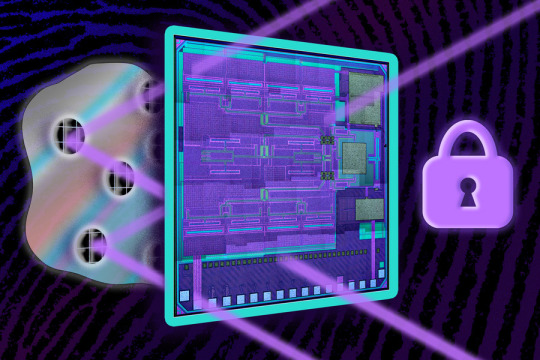
A Few Years Ago, MIT Researchers Invented a Cryptographic ID Tag that is several times smaller and significantly cheaper than the traditional radio frequency tags (RFIDs) that are often affixed to products to verify their authenticity.
This tiny tag, which offers improved security over RFIDs, utilizes terahertz waves, which are smaller and travel much faster than radio waves. But this terahertz tag shared a major security vulnerability with traditional RFIDs: A counterfeiter could peel the tag off a genuine item and reattach it to a fake, and the authentication system would be none the wiser.
The researchers have now surmounted this security vulnerability by leveraging terahertz waves to develop an antitampering ID tag that still offers the benefits of being tiny, cheap, and secure.
They mix microscopic metal particles into the glue that sticks the tag to an object, and then use terahertz waves to detect the unique pattern those particles form on the item’s surface. Akin to a fingerprint, this random glue pattern is used to authenticate the item, explains Eunseok Lee, an electrical engineering and computer science (EECS) graduate student and lead author of a paper on the antitampering tag.
“These metal particles are essentially like mirrors for terahertz waves. If I spread a bunch of mirror pieces onto a surface and then shine light on that, depending on the orientation, size, and location of those mirrors, I would get a different reflected pattern. But if you peel the chip off and reattach it, you destroy that pattern,” adds Ruonan Han, an associate professor in EECS, who leads the Terahertz Integrated Electronics Group in the Research Laboratory of Electronics.
The researchers produced a light-powered antitampering tag that is about 4 square millimeters in size. They also demonstrated a machine-learning model that helps detect tampering by identifying similar glue pattern fingerprints with more than 99 percent accuracy.
Because the terahertz tag is so cheap to produce, it could be implemented throughout a massive supply chain. And its tiny size enables the tag to attach to items too small for traditional RFIDs, such as certain medical devices.
The paper, which will be presented at the IEEE Solid State Circuits Conference, is a collaboration between Han’s group and the Energy-Efficient Circuits and Systems Group of Anantha P. Chandrakasan, MIT’s chief innovation and strategy officer, dean of the MIT School of Engineering, and the Vannevar Bush Professor of EECS. Co-authors include EECS graduate students Xibi Chen, Maitryi Ashok, and Jaeyeon Won.
Preventing Tampering
This research project was partly inspired by Han’s favorite car wash. The business stuck an RFID tag onto his windshield to authenticate his car wash membership. For added security, the tag was made from fragile paper so it would be destroyed if a less-than-honest customer tried to peel it off and stick it on a different windshield.
But that is not a terribly reliable way to prevent tampering. For instance, someone could use a solution to dissolve the glue and safely remove the fragile tag.
Rather than authenticating the tag, a better security solution is to authenticate the item itself, Han says. To achieve this, the researchers targeted the glue at the interface between the tag and the item’s surface.
Their antitampering tag contains a series of miniscule slots that enable terahertz waves to pass through the tag and strike microscopic metal particles that have been mixed into the glue.
Terahertz waves are small enough to detect the particles, whereas larger radio waves would not have enough sensitivity to see them. Also, using terahertz waves with a 1-millimeter wavelength allowed the researchers to make a chip that does not need a larger, off-chip antenna.
After passing through the tag and striking the object’s surface, terahertz waves are reflected, or backscattered, to a receiver for authentication. How those waves are backscattered depends on the distribution of metal particles that reflect them.
The researchers put multiple slots onto the chip so waves can strike different points on the object’s surface, capturing more information on the random distribution of particles.
“These responses are impossible to duplicate, as long as the glue interface is destroyed by a counterfeiter,” Han says.
A vendor would take an initial reading of the antitampering tag once it was stuck onto an item, and then store those data in the cloud, using them later for verification.
AI For Authentication
But when it came time to test the antitampering tag, Lee ran into a problem: It was very difficult and time-consuming to take precise enough measurements to determine whether two glue patterns are a match.
He reached out to a friend in the MIT Computer Science and Artificial Intelligence Laboratory (CSAIL) and together they tackled the problem using AI. They trained a machine-learning model that could compare glue patterns and calculate their similarity with more than 99 percent accuracy.
“One drawback is that we had a limited data sample for this demonstration, but we could improve the neural network in the future if a large number of these tags were deployed in a supply chain, giving us a lot more data samples,” Lee says.
The authentication system is also limited by the fact that terahertz waves suffer from high levels of loss during transmission, so the sensor can only be about 4 centimeters from the tag to get an accurate reading. This distance wouldn’t be an issue for an application like barcode scanning, but it would be too short for some potential uses, such as in an automated highway toll booth. Also, the angle between the sensor and tag needs to be less than 10 degrees or the terahertz signal will degrade too much.
They plan to address these limitations in future work, and hope to inspire other researchers to be more optimistic about what can be accomplished with terahertz waves, despite the many technical challenges, says Han.
“One thing we really want to show here is that the application of the terahertz spectrum can go well beyond broadband wireless. In this case, you can use terahertz for ID, security, and authentication. There are a lot of possibilities out there,” he adds.
This work is supported, in part, by the U.S. National Science Foundation and the Korea Foundation for Advanced Studies.
#Research 🔬 | Computer 🖥️ Chips | Internet 🛜 of Things | Electronics | Sensors | Computer 🖥️ Science & Technology#Artificial intelligence | Machine Learning | Supply Chains | Research 🔬 Laboratory of Electronics#Electrical Engineering & Computer Science (EECS) | School of Engineering | MIT Schwarzman College of Computing#| National Science Foundation (NSF)
0 notes
Text

Let's Explore a Metal-Rich Asteroid 🤘
Between Mars and Jupiter, there lies a unique, metal-rich asteroid named Psyche. Psyche’s special because it looks like it is part or all of the metallic interior of a planetesimal—an early planetary building block of our solar system. For the first time, we have the chance to visit a planetary core and possibly learn more about the turbulent history that created terrestrial planets.
Here are six things to know about the mission that’s a journey into the past: Psyche.

1. Psyche could help us learn more about the origins of our solar system.
After studying data from Earth-based radar and optical telescopes, scientists believe that Psyche collided with other large bodies in space and lost its outer rocky shell. This leads scientists to think that Psyche could have a metal-rich interior, which is a building block of a rocky planet. Since we can’t pierce the core of rocky planets like Mercury, Venus, Mars, and our home planet, Earth, Psyche offers us a window into how other planets are formed.

2. Psyche might be different than other objects in the solar system.
Rocks on Mars, Mercury, Venus, and Earth contain iron oxides. From afar, Psyche doesn’t seem to feature these chemical compounds, so it might have a different history of formation than other planets.
If the Psyche asteroid is leftover material from a planetary formation, scientists are excited to learn about the similarities and differences from other rocky planets. The asteroid might instead prove to be a never-before-seen solar system object. Either way, we’re prepared for the possibility of the unexpected!

3. Three science instruments and a gravity science investigation will be aboard the spacecraft.
The three instruments aboard will be a magnetometer, a gamma-ray and neutron spectrometer, and a multispectral imager. Here’s what each of them will do:
Magnetometer: Detect evidence of a magnetic field, which will tell us whether the asteroid formed from a planetary body
Gamma-ray and neutron spectrometer: Help us figure out what chemical elements Psyche is made of, and how it was formed
Multispectral imager: Gather and share information about the topography and mineral composition of Psyche
The gravity science investigation will allow scientists to determine the asteroid’s rotation, mass, and gravity field and to gain insight into the interior by analyzing the radio waves it communicates with. Then, scientists can measure how Psyche affects the spacecraft’s orbit.

4. The Psyche spacecraft will use a super-efficient propulsion system.
Psyche’s solar electric propulsion system harnesses energy from large solar arrays that convert sunlight into electricity, creating thrust. For the first time ever, we will be using Hall-effect thrusters in deep space.
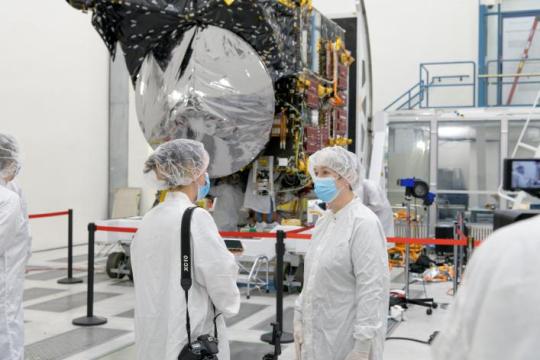
5. This mission runs on collaboration.
To make this mission happen, we work together with universities, and industry and NASA to draw in resources and expertise.
NASA’s Jet Propulsion Laboratory manages the mission and is responsible for system engineering, integration, and mission operations, while NASA’s Kennedy Space Center’s Launch Services Program manages launch operations and procured the SpaceX Falcon Heavy rocket.
Working with Arizona State University (ASU) offers opportunities for students to train as future instrument or mission leads. Mission leader and Principal Investigator Lindy Elkins-Tanton is also based at ASU.
Finally, Maxar Technologies is a key commercial participant and delivered the main body of the spacecraft, as well as most of its engineering hardware systems.
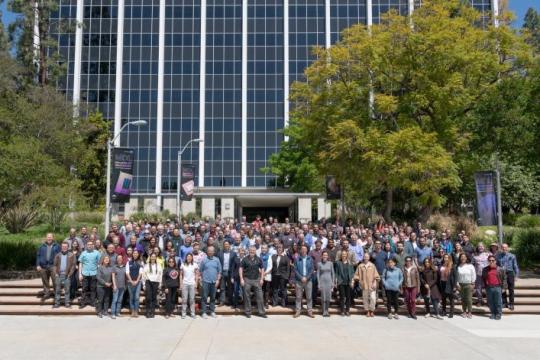
6. You can be a part of the journey.
Everyone can find activities to get involved on the mission’s webpage. There's an annual internship to interpret the mission, capstone courses for undergraduate projects, and age-appropriate lessons, craft projects, and videos.
You can join us for a virtual launch experience, and, of course, you can watch the launch with us on Oct. 12, 2023, at 10:16 a.m. EDT!
For official news on the mission, follow us on social media and check out NASA’s and ASU’s Psyche websites.
Make sure to follow us on Tumblr for your regular dose of space!
#Psyche#Mission to Psyche#asteroid#NASA#exploration#technology#tech#spaceblr#solar system#space#not exactly#metalcore#but close?
2K notes
·
View notes
Text
In Unrequited Love
Love and relationships can't be forced but sometimes they can be built on common ground and an understanding of one another's tribulations.
Part 2 here
Donatello x Reader

Having a crush on someone sucks. Having a crush on someone who has eyes for someone else sucks even more. This is the sad truth of your current circumstances. You knew that high school would come with its challenges but you weren’t prepared for the fact that you’d fall for the careless, hockey-loving maniac from your math class. It began with a casual friendship before feelings deepened on your end. Feelings that wouldn’t seem so terrible were it not for April O’Neil. You have absolutely nothing against the girl but it’s clear as day that she unfortunately has Casey’s heart in her stronghold. It’s not like you could even vent these frustrations, given that the only friends you have happen to be those two people.
Then, through some shenanigans that seem like the norm for you now, you meet four turtle brothers - one of whom is in the same boat as you. Not to mention, between the very two friends in question. Were it not heartbreaking to witness each other trying your hardest to grab the attention of your crushes, you’d find some humour in this.
You tried hanging out with Raphael more in an attempt to get in close quarters with Casey, seeing as they’re practically tied at the hip, only for you to realise that the rough-and-tumble environment isn’t your strong suit. That’s when they both suggested you try your hand at assisting Donatello in his laboratory given your aptitude for the sciences. What they failed to realise is that you do well in class but that doesn’t inherently mean you enjoy it. Theoretical sciences and learning about how things work are interesting but there aren’t enough practical applications that allow you to engage in the school environment. The closest you’ve gotten to having fun was when you made “elephant toothpaste” for a chemistry lesson but that’s about it.
Nonetheless, you see no harm in passing by the lab and giving the brainiac brothers a visit. Other than your not-so-subtle pining towards the other humans in the group, nothing has been outwardly mentioned about the situation you are both in. Neither of you has hung out enough to have that conversation. It wouldn’t be weird to talk about it, would it? A query that shall not yet receive an answer seeing as you’ve already knocked on the large, metal door. You walk through the open garage to see a couple of legs poking out from under the battle shell.
“Huh? Oh! (Y/n), sorry- Ow!” He slides out from beneath the vehicle and rubs the fresh bruise forming on his head. “Sorry, I’m a little busy, right now. I think Leo is watching Space Heroes if you’re looking for someone to hang out with, though.”
“Actually, I came by to see if you needed any help,” you offer, holding your hands behind your back respectfully whilst also trying not to laugh.
His eyes widen, having not expected such a proposal, and he’s quick to scramble to his feet. “Oh, okay! Let’s see- uh… how are you with engine repairs?”
“Depends.” Your tongue clicks contemplatively. “Is it gas, electric, or hybrid?”
“That already tells me you know more than enough,” he chuckles. “Here, I’ll show you.”
He opens the hood of the van to reveal the ensemble of burnt-out parts and overworked mechanisms. The guys’ last mission must have been intense because this engine is almost in complete disarray. Were it not for the fact that your Uncle is a mechanic, you’d be sweating under the pressure of somehow ruining this heap of metal more than it already is. A probability still if you want to jinx your person but that’s getting ahead of yourself.
Donatello gestures towards a box of spare parts and holds the back of his neck. “These just need to be taken out and replaced. It’s probably the easiest of what needs doing but I also need to finish rewiring the brakes, check the throttle calibration, replenish the weapons ammunition-”
“You need an extra set of hands to get it done quicker,” you cut him off with a smile. “I’ll see what I can do.”
He bares a gap-toothed smile in response and nods before resuming his initial position beneath the vehicle to finish the brake wiring. This leaves you to begin on your assigned job. For starters, you’re glad that this is a case of piecemeal repair rather than a complete engine rebuild. You’d be out of your depth were that the case. You start by pulling the entire engine out via a hoist, assisted by a load levelling bar so that it doesn’t tilt at a funny angle. Then, you secure it onto a stand and glance over what you’re working with. The crankshaft, piston ring compressor, oil filter, and fan need the most attention, so you start with those first. Just to save the disturbance, you look into a few tutorials on your phone to make sure you’re doing it correctly.
During this entire time, the two of you work on separate parts of the battle shell in silence, seemingly content with your tasks. By now, Donnie has moved on to tightening the wheels’ lug holes. Admittedly, you had been concerned about a lack of things to talk about but this is a nice settlement. It’s certainly the most relaxed you’ve felt in a while; something to keep you distracted from the quelling of your hopeless romantic attraction. Plus, you have this sense of relief from finally being able to work on something with your hands rather than straining your brain over textbooks and pop quizzes.
"Question,” he starts abruptly, keeping his eyes on the centre cap of the wheel. “What’s it you like so much about that cave mouth?"
First, you blink quickly to yourself, having not expected to get into the nitty gritty of it so soon. So much for being distracted but you can’t be mad. Curiosity isn’t something to be berated. Then, you find yourself snickering at the mildly degrading nickname. The question may appear brash but he’s puzzled by why April seems to like Casey so much. Hearing it from you might give him the insight he needs to turn the odds in his favour. He’ll take anything at this point.
"I dunno. There's just this air to him that I like. He's an ass, I am well aware of that, but he's fun, you know?” you admit awkwardly. “Psh! Don't ask me to explain it. You can't really put that stuff into words." You squint down at him, lips poised mockingly. "What is it you like about April so much?"
He halts his own task and glances down at his hands, cheeks reddening as he thinks about the girl of his dreams. "She just... had my heart from the first moment I saw her."
"Wow. The first girl you ever see in your life and it's just like that.” Yes, that bit of information is known thanks to our dear Raphael. “'Pretty shallow to fall in love with someone based on looks if you ask me."
"You would know,” he scoffs sarcastically.
"Now you're calling Casey ugly?” you ask, both playful and moderately offended on your crush’s behalf. “Man, you really don't like him."
"I’m sure the same goes for you with April!"
"Hey! I don't stoop so low into my dissatisfaction of the circumstances to insult her." A wry grin then beckons your lips. "Although~"
"Whatever you think you're going to say, don't."
The staring match doesn't last long, breaking beneath a shared laugh; fond and unwilted by the ache in your hearts, which has been forgotten for a split moment to enjoy each other's company.
From that point on, that’s precisely what you did. More often than not, you found yourself in the confines of his garage, assisting him with the occasional doohickey and thingymabob. Even if there wasn’t much you could help with, you wound up being a decent lab partner in any case. In turn, he would offer to help you with your homework if you had any particularly difficult assignments. Your grades have never looked so good. When neither of you were doing that, you’d simply hang out and rant about little annoyances with your unreciprocated infatuations.
“I mean, I try some jokes here and there but nothing seems to land,” he concedes begrudgingly, throwing his body weight into the back of his chair.
“Can I hear one?” you inquire as you gently swing around in your own seat.
His lips press together and he mulls it over before sighing, “Okay, so, you remember how I told you about Metal Head?” You nod, to which he continues, “Well, the first time I took him out for a spin, we were on watch duty together. That’s when I asked her if she likes metal.”
He groans to himself as he replays the memory in his head, only now realising how corny that must have sounded at the time. However, you laugh and not the heckling kind either. Your head tilts back into your chair, knees lifting to compensate for the tension in your shaking stomach. How could April have not loved something as precious as that? The girl must be crazy because that would have worked on you in a heartbeat.
“You should’ve asked if her favourite dance move is the robot,” you say in between laughs. “No, wait, wait! I got a better one! Ask her out to the circuits for a date!”
Donatello can only smile at your self-induced amusement, happy that there’s an appreciation for nerdy pickup lines and puns. They may not work on his crush - and his brothers sure don’t find them that funny - but he’s glad at least one person around here gets it.
It felt good to know that you had a friend you could be closer to because of your mutual understanding. For the first time since you realised your feelings for your schoolmate, you didn’t feel so alone. This bond formed on cluttered affection may have seemed unlikely to begin with but who are you to complain now? You and Donnie have a good thing going given your positions.
That is until your heart diverts its attention towards the very turtle.
You came to the realisation when he expressed his excitement in showing you his newest invention. The fact that he had called upon you first made you feel special. It made you feel wanted and desired for the first time in your life. A seemingly small phenomenon given how he merely wanted to showcase something to you but the way it had tugged your heart was unparalleled to anything else you had ever experienced - and that smile. You could have happily fawned over that proud grin of proclaimed accomplishment and self-justified pride for the rest of that day. Then, it all came crashing down on you like heaps of scrap in a junkyard. You have fallen for someone who is in love with April. Again. Are you just doomed to fall for any man that crushes this girl? This must be some sick joke. One that you don’t find yourself laughing at.
It eats away at you for the days - weeks - to come. You can’t console anyone on the matter, either. If any of his family catches wind, there’s a chance of him finding out. An outcome you wish to avoid if possible. As for Casey and April, dear lord you don’t even want to know what would happen if you told them. You’re at square one again just as before: crushing on someone who will never feel the same way about you. Rotting in a pool of your self-made disillusion.
Alone.
Having a crush on someone sucks.
#tmnt#tmnt 2012#donatello#donatello hamato#donatello 2012#donatello x reader#x reader#donnie tmnt#2012 donnie
235 notes
·
View notes
Text
Once again, some engineering undergraduates have overestimated their own prowess and summoned something when they should have been finishing their homework. The engineering TAs would like to take this moment to remind all the engineering majors that it is not a part of our jobs to track down whatever you summon and that you will fail any and all assignments that summon anything. As per university policy, we cannot grade summonings.
As a precaution, until further notice, the maker’s space is now closed to all students. Access will only be allowed under the direct supervision of a TA (good luck finding us) or a professor (assuming you can find one outside of office hours). All senior theses must be hypothetical - any practical theses proposals have been retroactively rescinded. Laboratory research is expected to continue as usual.
Safety is everyone’s responsibility when working with the unknown! Your TAs have prepared some helpful reminders to reduce the chances this happens again.
Complete the mandatory Elsewhere Lab Safety Training! If you do not complete this by the end of the quarter, things will befall you! Don’t test our patience!
Never work alone in the lab! Not only is this bad practice for most experiments, but two are better than one when it comes to stopping unusual lab problems.
Carry your iron rod, salt packet, and water bottle at all times. Replacement rods are available at the academic advising office, salt packets can be taken from the dining halls, and water bottles can be found at the athletics department.
All projects must be made out of iron. For iron alloys and composites, consult a TA, professor, or postdoc to see if the iron percentage is higher than the threshold.
Follow university policy regarding safety best practices in the classroom and around campus.
Bioengineers: only use samples acquired directly from other labs. Neither Elsewhere University nor the Engineering Department can guarantee that samples arrive uncontaminated (remember the Great Homunculi disaster?).
Electrical engineers: the efficacy of copper against the Fair Folk is still yet to be determined. Do not listen to the upperclassmen who tell you that copper works just as well as iron. This has been suspected to be a way of hazing new students and violated the university hazing policies.
Chemical engineers: use the fume hoods. Accidents happen much less often when working in a well-ventilated area.
Civil engineers: your steel pins may contain too little iron to be useful. Do not rely on them in a pinch. Yes, they look cool, but it’s better to be safe than sorry. Your faculty advisors will be conducting iron checks to ensure you have enough iron on you at all times.
Mechanical engineers: how many times do we have to remind you that just because something could work doesn’t mean it’s a good idea to build it? Remember the machine that nonstop summoned things for weeks? And how hard that was to stop? Please don’t build that again, or anything like it.
And, as always, report accidents to the relevant safety authorities. The sooner the damage is evaluated, the sooner it can be contained and fixed.
On behalf of the entire department, we preemptively thank you for adjusting to this change in departmental policy.
Please understand that your midterm grades will be coming out late, as we are working hard to understand what was summoned and how: if anyone has information about it, please direct it to the Dean’s office.
- your engineering TAs
243 notes
·
View notes
Text

Talaria Mark IV Video Projector, 1961
General Engineering Laboratory,
General Electric Company, Schenectady, New York
image credit: Harold R. Day/General Electric
via: The Museum of Innovation and Science, NY
New York Heritage Digital Collections
64 notes
·
View notes
Text
Writing Scientist Characters
this post is mainly an excuse to post a certain list of lab supplies I've made for a friend and infodump about lab work. but feel free to use this as a little resource when writing characters who are scientists and/or lab nerds. who knows, maybe it'll be of use.
General thoughts
Many people think it's a stereotype that scientist or nerd characters talk using complex technical jargon. While that is true to an extent, there actually is some kind of lab jargon. It varies across different labs and fields, but one thing they have in common is that it seeks to simplify, not the other way around.
gelelectrophoresis becomes elpho
microbiology becomes mibi
deioninized water becomes aqua dist
biochemistry becomes BC
sodium hydroxide becomes NaOH
They will probably not call a glass of water "silicon dioxide and h2o".
...and more. feel free to get creative. If you're writing in any other language than English, you can throw in one or two anglicisms as well. Also, most scientists will never gatekeep their work, and in an opposite fashion, will not shut up about it unless you make them. And no, most chemists do not know the entire periodic table by heart, only the most relevant elements. (main groups and a few commonly used metals of the subgroups)
When it comes to characters doing the lab work, keep in mind that there are a lot more people involved than the scientist themself. Most scientists are more occupied with paperwork and data analysis, it is the laboratory technicians and assistants that do most of the practical work. They often have more lab experience than the scientists themselves.
Things you can have your lab nerd character do instead of making random chemicals explode
writing a lab report (and losing their mind over excel)
degreasing the glass bevel stoppers
removing the permanent marker from beakers (labeling is important)
complaining about the lack of funding of [their field] research
cleaning glassware
preparing specimen for examination
googling the most basic equations for their report
checking if the glassware and utensil collections are complete
steal single use plastic pipettes from their lab
pirating expensive textbooks
A list of laboratory supplies and utensils you can have them work with
Laboratory general (chem + bio)
Erlenmayer flasks, beakers, precision scales (3 digits), glass rods, metal spoons/spatulas, screw on glass flasks (autoclave compatible) test tubes, stopcock grease, dispensers with sanitizer and hand cream, gas burners, heating plates, eppendorf pipettes, pipette tips, Peleus pipetting aids, squirting bottles, liquid and powder funnels, incubator/drying chamber, round watch glasses, magnet stirring plates.
Microbiology
Autoclave, petri dishes, agar plates, innoculation loops (reusable and metal), clean bench, microscope slides, microscope, drigalski-spatula, test tubes with clamping lids
Histology
Paraffin bath, water bath, scalpels, scissors, razor blades, microtomes (rotating microtome, slide microtome and freezing microtome), histocinette, tweezers (various kinds), ocular
Biochemistry
Sequencing robots, eppendorf tubes, gelelectrophoresis chambers, centrifuge
Analytical Chemistry
Photometer, kuvettes, burettes, mass spectro meters, UV bank (for chromatogrophies), pyknometers, melting point meter, porcelain mortars, pH paper, analytical scales (4 or more digits)
Prep Chemistry
Tripod/standing material, miniature lifting platforms, spiral condenser, colon condenser, round bottom flask (three necked and y- necked), filtration material, Separating funnel
Electrical engineering
Electric generators, Soldering iron, Clamp connectors, plugin connectors, ohm’s resistors, plug in lamps, condensers, transistors, PCBs, amperemeters, voltmeters, multimeters
Mechanics
Tripod/standing material, metal hooks, metal rods, mechanical stop watches, marbles, metal springs, Newton meters, laser motion detectors
Optics
Prisma (various kinds), various glass lenses (concave, convex, biconcave, biconvex), laser pointers, optical bench, mechanical iris diaphragm, looking glasses, monochrome lamps, lamp filters
Most used chemicals
Deionized water, ethanol, NaOH, HCl, H3PO4, NaCl (+ physiological NaCl solution 0.9)
Useful websites for writing science stuff
DNA sequence generator (simple):
http://www.faculty.ucr.edu/~mmaduro/random.htm
DNA, RNA and protein sequence generator:
https://molbiotools.com/randomsequencegenerator.php
Annealing temperature calculator:
https://tmcalculator.neb.com/#!/main
Medicine name generator:
https://www.fantasynamegenerators.com/medicine-names.php
Anything chemistry related:
https://www.wolframalpha.com/input?i=chemistry
Commonly used software:
MS Excel
Yenka
CASSY Lab
LabView
SpectraLab
LIMS
LaTex
Slack
Scientist friends, feel free to add onto this.
Have fun writing!
#creative writing#writing#resource#writing resources#science#biology#chemistry#physics#writing guide#writers on tumblr#writeblr#rp#rp resources
103 notes
·
View notes
Text

Laboratory Safety: The Hierarchy of Controls
Though many people may think of safety glasses or lab coats as the safest way to protect oneself in a laboratory setting, personal protective equipment (PPE) is actually considered the last and least effective step. The goal with safety in laboratories is almost always to make the use of PPE unnecessary or redundant - with the caveat and acknowledgement that sometimes, that just isn't possible.
Nevertheless, let's take a look at the steps that come before PPE:
Elimination of the hazard. Examples might be restricting the use of extension cords (possible trip hazard); doing work at ground level (e.g., eliminating the use of a ladder and bringing the work to the floor); or updating old or faulty equipment that might be more dangerous than modern versions.
Substitution of the hazard. Similar to elimination, examples include replacing chemicals with less dangerous versions that can perform the same task, or using less electricity or temperature.
Engineering controls serve to isolate people from hazards. Examples include chemical fume hoods, an interlock system for a laser setup, or remote controls to operate equipment from a distance.
Administrative controls are the rules and regulations that govern a laboratory space. They can include working on a buddy system, additional safety training, mandating rest breaks, putting up warning signs and labels, and developing standard operating procedures.
Sources/Further Reading*: (Image source - CDC) (OSHA) (OSHA hierarchy of controls) (SafetyCulture) (Lab Manager)
*Note: If you are looking for lab safety resources, any university with working laboratories should have guidelines available. Just keep in mind that as the rules get more specific, some may be location dependent (i.e., based on the local laws of the state, province, country, etc.).
86 notes
·
View notes
Text
A Century Ahead Of Our Time

After his unfortunate laboratory fire in 1895, which destroyed nearly all his work and research, Nikola Tesla was immediately back in a new laboratory experimenting with his wireless theories. As early as 1896, Tesla was already sending signals from his laboratory in New York City to West Point, located roughly 30 miles north of his lab. He continued these experiments and many others until he realized he needed more space than what the crowded city could offer.
In 1899, he developed a laboratory station in Colorado Springs, Colorado in hopes of developing a transmitter of great power, to perfect means for individualizing and isolating the energy transmitted, and also to ascertain the laws of propagation of currents through the earth and the atmosphere. Tesla ultimately believed that it is practicable to disturb the electrostatic condition of the earth and by developing large enough machinery he could grip the earth with electricity, use it as a conductor, and transmit signals and power through it.
While in Colorado, Nikola Tesla was informed numerous times by his secretary about the many other competitors in the wireless art. There was George H. Clark, who was sending messages up to 3 miles. There was also Professor Marble in Connecticut, Dr. Riccia in France, and Professor D'Azar in Rome. Guglielmo Marconi was the biggest competitor who was sending messages up to 20 miles in America at the America's Cup boat races. Although Tesla's secretary was worried that Tesla might be wasting time in Colorado while others were getting the jump on him, Tesla confidently replied:
"Do not worry about me. I am about a century ahead of the other fellows."
In January of 1900, Tesla would leave Colorado fully convinced that he accomplished all he set out to do. He would then set out to engineer and build his machines on a large scale, but ended up lacking the investments and funds to finish his work in its entirety. Some say he failed because his idea didn't work, but that's not true at all because his Colorado experiments proved that they did. He simply underestimated the cost of his system. Unfortunately, his failings to fulfill his dreams and finish his work would leave him with the public persona as being the mad scientist who had unrealistic ideas for the future. Although we are advancing with great strides in technological achievements, we are still a century behind the future Nikola Tesla hoped and dreamed for.

#nikola tesla#science#history#quotes#wireless#electricity#power#technology#ahead of his time#ahead of our time
440 notes
·
View notes
Photo

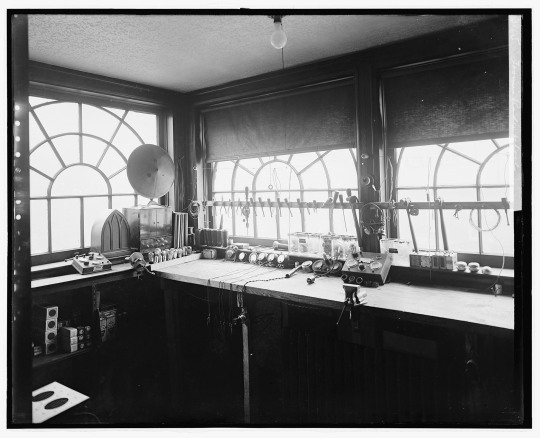
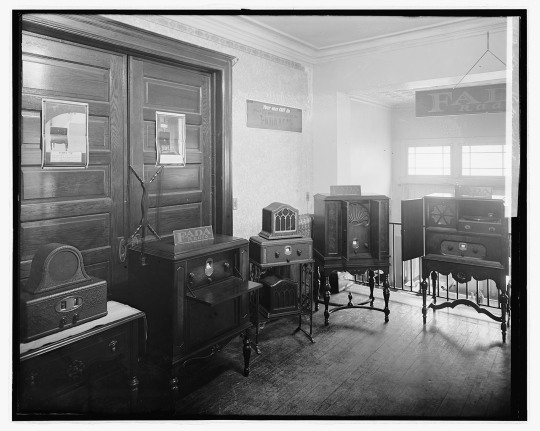
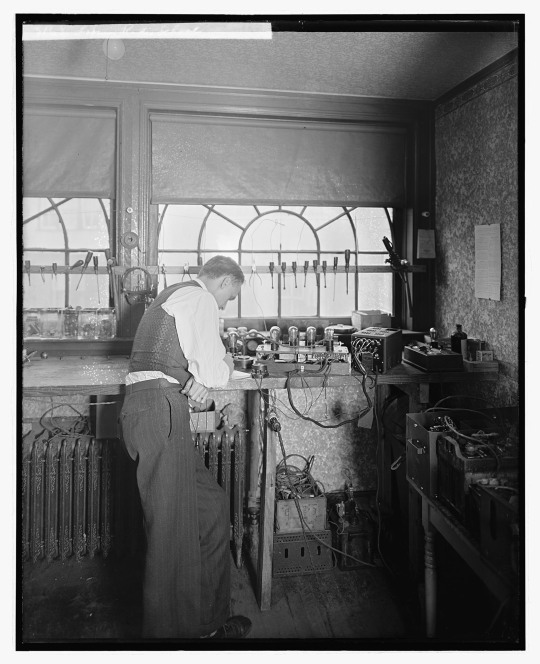
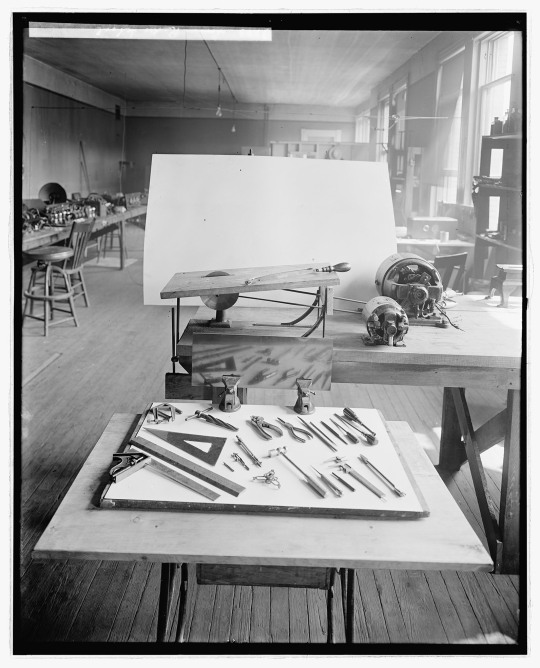

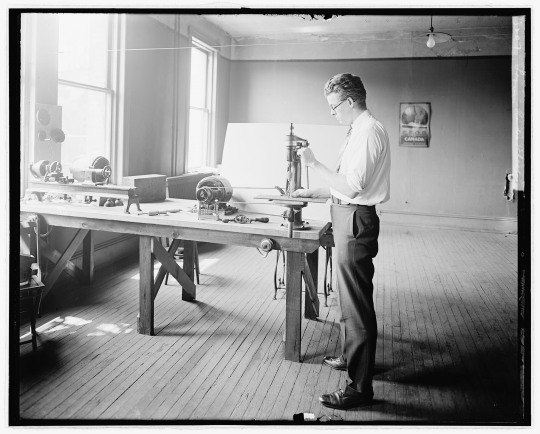
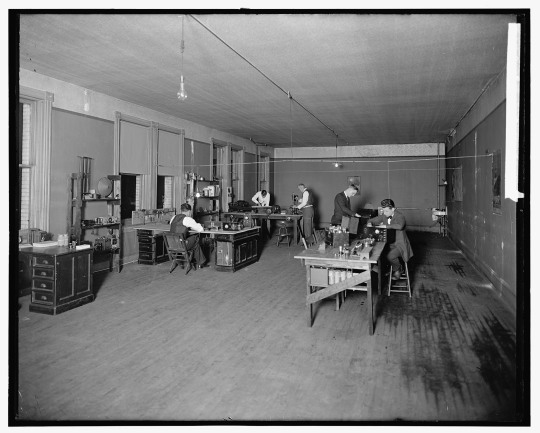
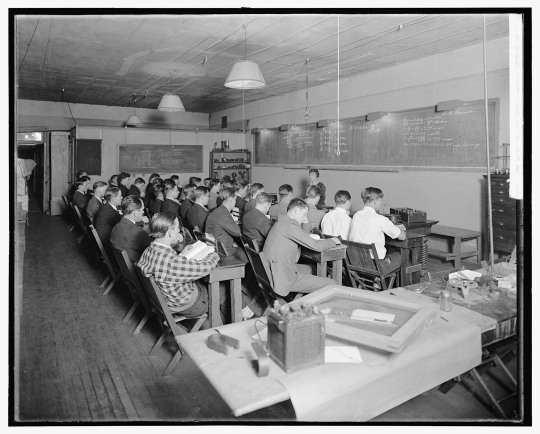
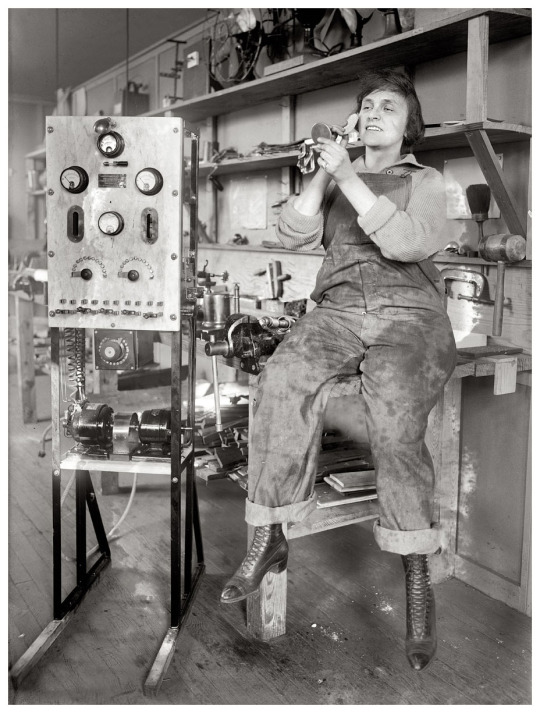
The Loomis Radio School, Washington D.C. ca. 1921.
The school was located at 401 Ninth St. N.W. and operated with the call letters 3YA. By 1920 it was offering a six month course enabling the graduate to obtain a first grade commercial radio license and by January of 1922 was offering a four year course with a degree in Radio Engineering bestowed on graduates.
The school was founded by Mary Texanna Loomis, pictured in the last photo.
Born August 18, 1880 near Goliad, Texas. She was the second child born to Alvin Isaac and Caroline (Dryer) Loomis. Though born on homestead in Texas in 1880, by 1883 her parents had returned to Rochester NY and then on to Buffalo where Alvin became president of a large delivery and storage company. Little is known of her early years, but appears she had a fairly middle-class up bringing. She seemed well schooled, with an early interest in music and language (she mastered French, German and Italian) Her early years were spent in Buffalo, NY and she later relocated to Virginia.
During the early years of World War I, she became interested in the new field of wireless telegraphy. There was a family precedent; her cousin, Dr. Mahlon Loomis, had conducted early wireless experiments with moderate success and may in fact have been the first person, in 1865, to send and receive wireless signals.
Mary soon became proficient enough in wireless telegraphy to be granted a license by the United States Department of Commerce. Thoroughly fascinated with the field now called “radio”, she decided to turn her expertise into a career. Also, she wanted to do something that would honor her pioneering ancestor. Her idea was to do this by founding a radio school.
Though radio was indeed, for many years, a profession dominated by men, Mary Loomis around age 40 took no notice and in 1920 founded the Loomis Radio School in Washington, D.C. and it quickly gained an excellent reputation. Ms. Loomis set high standards for the school and it attracted students not only from the United States but Europe and Asia as well. Loomis enjoyed teaching as much as she enjoyed radio itself. In an interview, she said, “Really, I am so infatuated with my work that I delight in spending from 12 to 15 hours a day at it. My whole heart and soul are in this radio school.”
As president and Lecturer of the Loomis Radio School, Mary authored a definitive book on radio, named “Radio Theory and Operating.”
By January 1922 the school was offering a four year course with a degree in Radio Engineering bestowed on graduates. Loomis also intended that her students understand more than just the inner and outer workings of radio. In addition to a radio laboratory (with equipment constructed almost entirely by Mary herself), the school maintained a complete shop capable of teaching carpentry, drafting and basic electricity. She reasoned that many of her graduates might find themselves at sea, or in other challenging situations and she wanted them adequately prepared. “No man,” Ms. Loomis said, at the time, “can graduate from my school until he learns how to make any part of the apparatus. I give him a blueprint of what I want him to do and tell him to go into the shop and keep hammering away until the job is completed.”
The school appears to have been in existence at least through the early 1930's, but it has not been possible to find information after that.
In an interview given to H.O. Bishop of the Dearborn Independent in 1921, Mary was asked: “What sort of young men are taking up the radio profession?” to which she replied:
“The Kind who have grit and want to get there! Virtually all of them are ambitious and enthusiastic over the possibility of visiting every nook and corner of the world. My students are not only enrolled from various sections of the USA and Canada but from many foreign countries, such as Sweden, Ireland, England, Poland, Russia, Austria, Rumania and the Philippines. One of the brightest pupils I ever had was Prince Walimuhomed of Far-away Afghanistan. He was an extremely modest young man, keeping his real identity a secret until after graduating. He said he had no idea of earning his living by working at radio, but just wanted to know all about it. He does.You have no idea how much happiness I get out of the success of each individual graduate. My boys keep in touch with me from all parts of the world. Scarcely a day goes by that I do not get some trinket or postcard from some remote section of the world. I have made the wonderful discovery that the only way for me to get happiness for myself is to make some one else happy. I find that I am making these young men happy by teaching them every phase of the radio business so that they can earn a comfortable living for themselves and their dependents and at the same time, see the great big beautiful world.
As far as we can figure out, Mary Loomis left Washington D.C. around 1935 and moved to San Francisco where she worked as a stenographer. She died in 1960 and is interred at Woodlawn Memorial Park, Colma, CA.
Source
155 notes
·
View notes
Text
Since January 2021, all new cars and small vans that can run on liquid fuels have to be equipped with approved on-board fuel consumption monitoring (OBFCM) devices before they can be placed on the EU market. These devices record the vehicles’ fuel or energy consumption and the total distance driven.
The first data from a sample of 600 000 cars indicates that the real-world fuel consumption and CO2 emissions from diesel and petrol vehicles on the road are around 20% higher than indicated by the official values from the standardised WLTP type-approval test used for regulatory purposes. This discrepancy is in line with what the Commission had anticipated.
For plug-in hybrid electric vehicles, the real-world CO2 emissions were on average 3.5 times higher than the laboratory values, which confirms that these vehicles are currently not realising their potential, largely because they are not being charged and driven fully electrically as frequently as assumed.
man that sucks. I would have assumed that especially in Europe PHEV would be really popular to charge at home since fuel costs are so high but if you're just using it as a conventional hybrid it's even worse because you're lugging around a bigger battery with a smaller engine. I wonder how much of that is poor understanding of how PHEV works and how much is difficulty accessing charging infrastructure. I guess if you're able to run on petrol you might just not change your normal habits as easily as with pure electrics.
The WLTP value being off by 20% for pure IC cars isn't that unusual, everyone knows that spec sheet fuel consumption is optimistic.
Some tables from the report itself, linked below the article
Dataset sampled

Representativeness
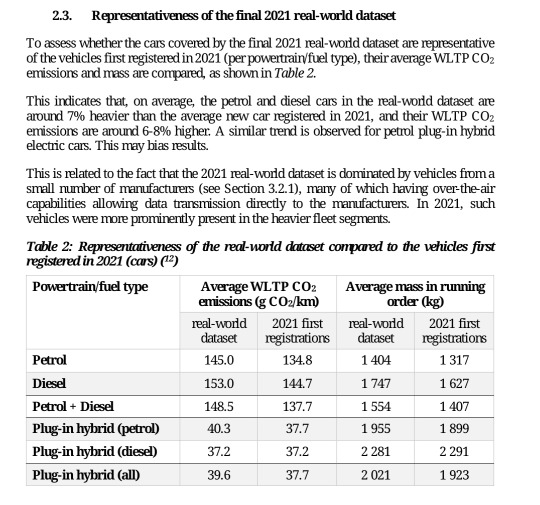
Total emissions and economy values being realized by vehicles in the dataset
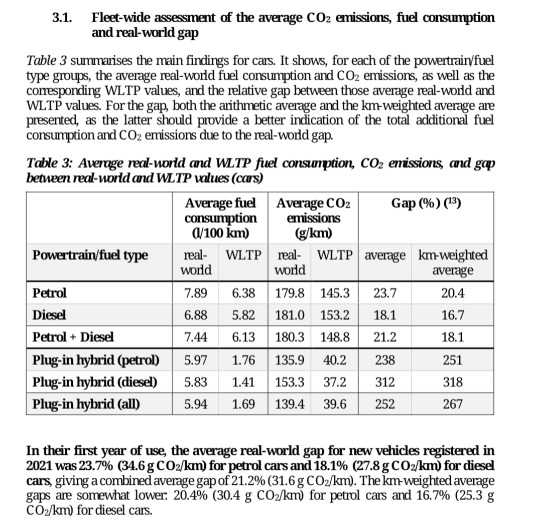
55 notes
·
View notes
Text
Scientists use generative AI to answer complex questions in physics
New Post has been published on https://thedigitalinsider.com/scientists-use-generative-ai-to-answer-complex-questions-in-physics/
Scientists use generative AI to answer complex questions in physics
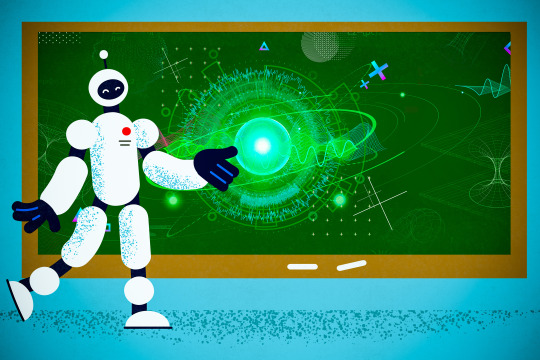

When water freezes, it transitions from a liquid phase to a solid phase, resulting in a drastic change in properties like density and volume. Phase transitions in water are so common most of us probably don’t even think about them, but phase transitions in novel materials or complex physical systems are an important area of study.
To fully understand these systems, scientists must be able to recognize phases and detect the transitions between. But how to quantify phase changes in an unknown system is often unclear, especially when data are scarce.
Researchers from MIT and the University of Basel in Switzerland applied generative artificial intelligence models to this problem, developing a new machine-learning framework that can automatically map out phase diagrams for novel physical systems.
Their physics-informed machine-learning approach is more efficient than laborious, manual techniques which rely on theoretical expertise. Importantly, because their approach leverages generative models, it does not require huge, labeled training datasets used in other machine-learning techniques.
Such a framework could help scientists investigate the thermodynamic properties of novel materials or detect entanglement in quantum systems, for instance. Ultimately, this technique could make it possible for scientists to discover unknown phases of matter autonomously.
“If you have a new system with fully unknown properties, how would you choose which observable quantity to study? The hope, at least with data-driven tools, is that you could scan large new systems in an automated way, and it will point you to important changes in the system. This might be a tool in the pipeline of automated scientific discovery of new, exotic properties of phases,” says Frank Schäfer, a postdoc in the Julia Lab in the Computer Science and Artificial Intelligence Laboratory (CSAIL) and co-author of a paper on this approach.
Joining Schäfer on the paper are first author Julian Arnold, a graduate student at the University of Basel; Alan Edelman, applied mathematics professor in the Department of Mathematics and leader of the Julia Lab; and senior author Christoph Bruder, professor in the Department of Physics at the University of Basel. The research is published today in Physical Review Letters.
Detecting phase transitions using AI
While water transitioning to ice might be among the most obvious examples of a phase change, more exotic phase changes, like when a material transitions from being a normal conductor to a superconductor, are of keen interest to scientists.
These transitions can be detected by identifying an “order parameter,” a quantity that is important and expected to change. For instance, water freezes and transitions to a solid phase (ice) when its temperature drops below 0 degrees Celsius. In this case, an appropriate order parameter could be defined in terms of the proportion of water molecules that are part of the crystalline lattice versus those that remain in a disordered state.
In the past, researchers have relied on physics expertise to build phase diagrams manually, drawing on theoretical understanding to know which order parameters are important. Not only is this tedious for complex systems, and perhaps impossible for unknown systems with new behaviors, but it also introduces human bias into the solution.
More recently, researchers have begun using machine learning to build discriminative classifiers that can solve this task by learning to classify a measurement statistic as coming from a particular phase of the physical system, the same way such models classify an image as a cat or dog.
The MIT researchers demonstrated how generative models can be used to solve this classification task much more efficiently, and in a physics-informed manner.
The Julia Programming Language, a popular language for scientific computing that is also used in MIT’s introductory linear algebra classes, offers many tools that make it invaluable for constructing such generative models, Schäfer adds.
Generative models, like those that underlie ChatGPT and Dall-E, typically work by estimating the probability distribution of some data, which they use to generate new data points that fit the distribution (such as new cat images that are similar to existing cat images).
However, when simulations of a physical system using tried-and-true scientific techniques are available, researchers get a model of its probability distribution for free. This distribution describes the measurement statistics of the physical system.
A more knowledgeable model
The MIT team’s insight is that this probability distribution also defines a generative model upon which a classifier can be constructed. They plug the generative model into standard statistical formulas to directly construct a classifier instead of learning it from samples, as was done with discriminative approaches.
“This is a really nice way of incorporating something you know about your physical system deep inside your machine-learning scheme. It goes far beyond just performing feature engineering on your data samples or simple inductive biases,” Schäfer says.
This generative classifier can determine what phase the system is in given some parameter, like temperature or pressure. And because the researchers directly approximate the probability distributions underlying measurements from the physical system, the classifier has system knowledge.
This enables their method to perform better than other machine-learning techniques. And because it can work automatically without the need for extensive training, their approach significantly enhances the computational efficiency of identifying phase transitions.
At the end of the day, similar to how one might ask ChatGPT to solve a math problem, the researchers can ask the generative classifier questions like “does this sample belong to phase I or phase II?” or “was this sample generated at high temperature or low temperature?”
Scientists could also use this approach to solve different binary classification tasks in physical systems, possibly to detect entanglement in quantum systems (Is the state entangled or not?) or determine whether theory A or B is best suited to solve a particular problem. They could also use this approach to better understand and improve large language models like ChatGPT by identifying how certain parameters should be tuned so the chatbot gives the best outputs.
In the future, the researchers also want to study theoretical guarantees regarding how many measurements they would need to effectively detect phase transitions and estimate the amount of computation that would require.
This work was funded, in part, by the Swiss National Science Foundation, the MIT-Switzerland Lockheed Martin Seed Fund, and MIT International Science and Technology Initiatives.
#ai#approach#artificial#Artificial Intelligence#Bias#binary#change#chatbot#chatGPT#classes#computation#computer#Computer modeling#Computer Science#Computer Science and Artificial Intelligence Laboratory (CSAIL)#Computer science and technology#computing#crystalline#dall-e#data#data-driven#datasets#dog#efficiency#Electrical Engineering&Computer Science (eecs)#engineering#Foundation#framework#Future#generative
2 notes
·
View notes
Photo
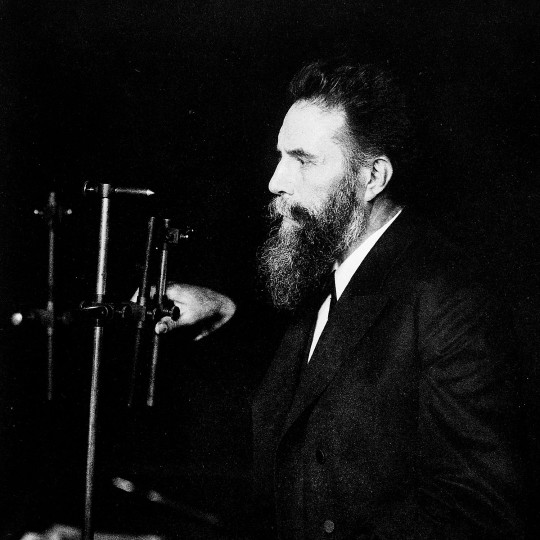
Discovery of X-Rays
The discovery of X-rays – a form of invisible radiation that can pass through objects, including human tissue – revolutionised science and medicine in the late 19th century. Wilhelm Conrad Röntgen (1845-1923), a German scientist, discovered X-rays or Röntgen rays in November 1895. He was awarded the first Nobel Prize for Physics for this discovery in 1901.
The thrill of the discovery became caught up in the late Victorian obsession with ghosts and photography. X-rays could 'photograph' the invisible, penetrating flesh, exposing bones and the human skeleton. 'Bone portraits' became popular, and photographers opened studios for a public fascinated by otherworldly images of skeletons.
Wilhelm Conrad Röntgen
Wellcome Collection (CC BY)
One of the first medical uses of X-rays occurred in 1896 when John Francis Hall-Edwards (1858-1926), a British doctor, located a needle embedded in a colleague's hand. X-ray technology soon moved from being seen as a new form of photography to a modern diagnostic tool used by hospitals and medical practitioners.
Wilhelm Conrad Röntgen was a meticulous scientist, but the discovery of X-rays may have been an unintentional result of his work with cathode rays in his Würzburg laboratory in Bavaria, Germany.
Early Years
Wilhelm Conrad Röntgen was born in Lennep, Prussia (Remscheid-Lennep, Germany) on 27 March 1845, to a German textile merchant father and a Dutch mother. He was an only child and spent his early years in Apeldoorn in the Netherlands. His father, Friedrich Conrad Röntgen (1801-1884), managed a cloth manufacturing business in Apeldoorn. The family had also moved due to political unrest in Prussia.
Röntgen attended the Utrecht Technical School from 1861 to 1863 but was expelled when a fellow student drew a caricature of a teacher. Röntgen was implicated but refused to name the student responsible. Despite excellent marks, he did not graduate with a technical diploma and could not obtain a degree in the Netherlands. He was accepted by the Mechanical Technical Division of the Federal Polytechnic School in Switzerland in 1865, where he gained a diploma in mechanical engineering and, in 1869, a PhD in physics with his thesis Studies on Gases.
The German experimental physicist August Kundt (1839-1894) was Röntgen's supervisor. In 1866, Kundt designed the Kundt Tube, a glass apparatus that measured the speed of sound in gases. Kundt significantly influenced Röntgen and his research career.
Röntgen followed Kundt to the University of Würzburg in 1870, where he worked as an unpaid assistant during a time of rapid advancements in experimental physics. Scottish mathematician James Clerk Maxwell (1831-1879) was researching electromagnetic radiation and established the connection between light and electromagnetic radiation. Maxwell also took the first colour photograph in 1861, based on his three-colour theory that the human eye sees colour through a combination of blue, red, and green light. Massachusetts-born Samuel Morse (1791-1872) developed the electric telegraph, which transmitted messages over long distances, and Morse code to encode messages, while Alexander Graham Bell (1847-1922) invented the telephone.
Of particular interest to Röntgen was the work of German physicist Heinrich Hertz (1857-1894) and British chemist William Crookes (1832-1919). Both scientists studied cathode rays – invisible streams of electrons whose behaviour can be observed when an electrical current is passed between the two electrodes (cathode and anode) in a glass vacuum tube. It is called a cathode ray because the electrons are emitted from the cathode (or negative electrode) when an electrical current heats it, and the electron stream glows. Johann Wilhelm Hittorf (1824-1914) was the first to detect cathode rays glowing green in the glass wall of a vacuum tube in 1869 but did not realise that X-rays had been produced during his experiments.
Röntgen became fascinated with the fluorescence caused by cathode rays hitting certain materials, such as salts like barium platinocyanide, which glow a greenish-yellow colour when exposed to cathode rays. It was this fascination that led to the discovery of X-rays.
Continue reading...
29 notes
·
View notes
Text
It can take years of focused laboratory work to determine how to make the highest quality materials for use in electronic and photonic devices. Researchers have now developed an autonomous system that can identify how to synthesize "best-in-class" materials for specific applications in hours or days.
The new system, called SmartDope, was developed to address a longstanding challenge regarding enhancing properties of materials called perovskite quantum dots via "doping."
"These doped quantum dots are semiconductor nanocrystals that you have introduced specific impurities to in a targeted way, which alters their optical and physicochemical properties," explains Milad Abolhasani, an associate professor of chemical engineering at North Carolina State University and corresponding author of the paper "Smart Dope: A Self-Driving Fluidic Lab for Accelerated Development of Doped Perovskite Quantum Dots," published open access in the journal Advanced Energy Materials.
"These particular quantum dots are of interest because they hold promise for next generation photovoltaic devices and other photonic and optoelectronic devices," Abolhasani says. "For example, they could be used to improve the efficiency of solar cells, because they can absorb wavelengths of UV light that solar cells don't absorb efficiently and convert them into wavelengths of light that solar cells are very efficient at converting into electricity."
Continue Reading.
67 notes
·
View notes
Text
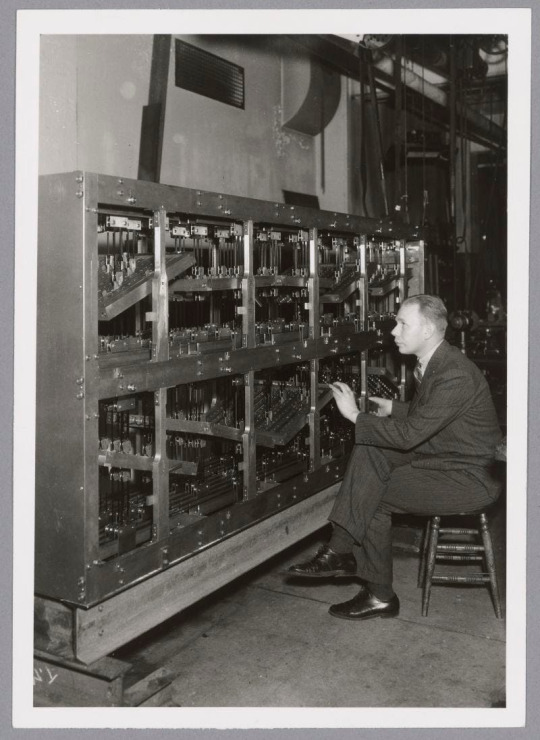
My great grandfather “Bud” Wilbur gave his son Jack an Erector Set one Christmas then took it back the same day. The Erector Set was a children’s toy made of metal pieces that allowed kids to build various model structures like bridges and poorly made bridges. Before video games, children had very few choices for entertainment: marbles, Erector Sets, or becoming a Peeping Tom. Those were the choices. My grandpa Jack was going to be an engineer like his father, and to seal his fate, great grandpa Bud bought him the tools to try his hand at building. Bud, seeing the pieces scattered on the floor must have thought “pearls before swine” while having his eureka moment. Using the toy he had bought his son, he built a model of what he called The Simultaneous Calculator, what the American papers in 1937 called “Robot-Einstein,” and what the Japanese dubbed “The Wilbur Machine.”
He didn’t build the first calculator. I believe that honor technically belongs to the Mesopotamians who made the first abacus. Nor did the calculator conceptually resemble the digital computing systems we have now that employ ones and zeros and a lot of electricity. The Wilbur Machine was an analog computing system with pulleys and brass bars that solved 9 equations simultaneously (or 9x9 systems according to an MIT grad’s thesis that I can only comprehend up to page 4). Math equations that once took a full day to solve now took roughly 1-3 hours. It sped up the production of large structures, power grids, and for one country it seems, planes. It was a big advancement in 1936-37, an advancement that was eclipsed by better smaller machines soon after. In the United States, that is. In Japan, a 3x3 system Wilbur Machine was replicated in the late 30s and a fully functioning 9x9 calculator was completed in 1944 at the Tokyo Imperial University’s Aviation Laboratory.
You read that correctly. My great-grandfather Bud Wilbur built a machine that was stolen by an Axis power right before World War II. Japan continued to use the machine until the war’s end. So, uh…sorry about that? It wasn’t Bud’s intention.
Read the rest of the essay here.
#essays#essay#writing#reading#personal essay#Japan#interesting#travel#science#math#MIT#Wilbur machine#dan wilbur#long reads#movies#family
28 notes
·
View notes